Key takeaways:
- Selective Mutism is a coping mechanism linked to anxiety, requiring understanding and patience from caregivers.
- Effective communication encompasses both verbal and nonverbal cues; silence can convey powerful messages.
- Creating a supportive environment and practicing active listening encourage individuals with Selective Mutism to express themselves.
- Building confidence in speaking involves small interactions, positive reinforcement, and preparing for conversations thoughtfully.

Understanding Selective Mutism
Selective Mutism is more than just a reluctance to speak; it often stems from deep-rooted anxiety in social settings. I remember my friend’s child, who would light up while playing alone but would freeze in the presence of others, often leading me to wonder: why is it that some children can articulate their thoughts in certain environments but struggle in others? This internal battle can be frustrating for both the child and their loved ones, creating an emotional gap in communication that is hard to bridge.
For many who experience Selective Mutism, the sounds of silence can be deafening. In my experience with children facing this challenge, I’ve seen how a friendly smile or simple gestures often mean more than words. It’s as if they’re silently communicating their desire to connect while wrestling with overwhelming feelings of fear and vulnerability. This emotional complexity is what makes understanding Selective Mutism so essential; every child has their unique story, waiting to be discovered.
It’s crucial to recognize that Selective Mutism is not a choice; it’s a coping mechanism. I often find myself reflecting on how crucial it is to foster patience and create safe spaces for these children. How can we better support them, I ask? By understanding their world and honoring their feelings, we can help ease their journey—transforming silence into a beautiful, albeit quiet, expression of their individuality.
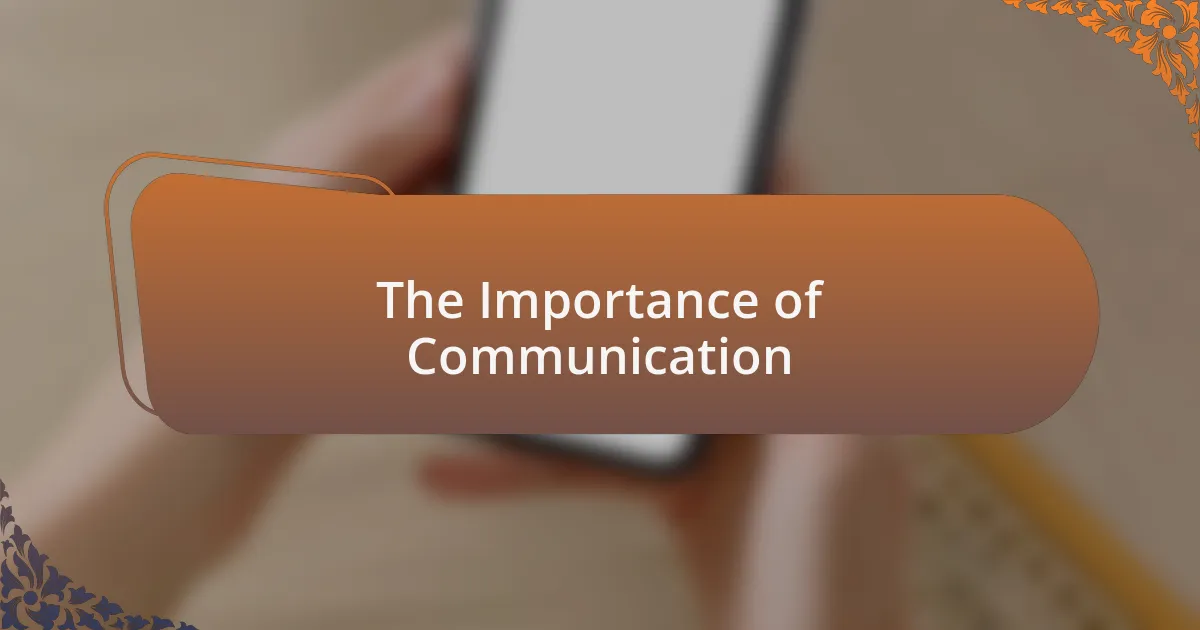
The Importance of Communication
The very act of communication holds immense power, especially for children grappling with Selective Mutism. I recall a moment when a child of a friend finally spoke up during a small group activity. The shift in their facial expression was palpable — a mix of joy and relief as they found their voice amidst understanding peers. This experience drives home the idea that communication isn’t just about words; it’s about connection, respect, and the validation of one’s feelings.
Additionally, I’ve observed that communication goes beyond verbal interaction. One day, I noticed a child drawing their thoughts instead of speaking. While others often dismissed their quietness as shyness, the drawing spoke volumes. It made me question: can we truly grasp the myriad ways people express themselves? This realization has deepened my understanding of how essential it is to create various avenues for communication, allowing every child to be heard, regardless of how they choose to express themselves.
Moreover, I often reflect on how silence can sometimes convey more than speech ever could. In my volunteer experiences, I’ve seen the profound effect even the simplest gestures can have. Whether a nod of agreement or a gentle touch on the shoulder, these actions signify understanding and support. Isn’t that what true communication is — recognizing and honoring each individual’s method of expression, even if it doesn’t conform to traditional norms?
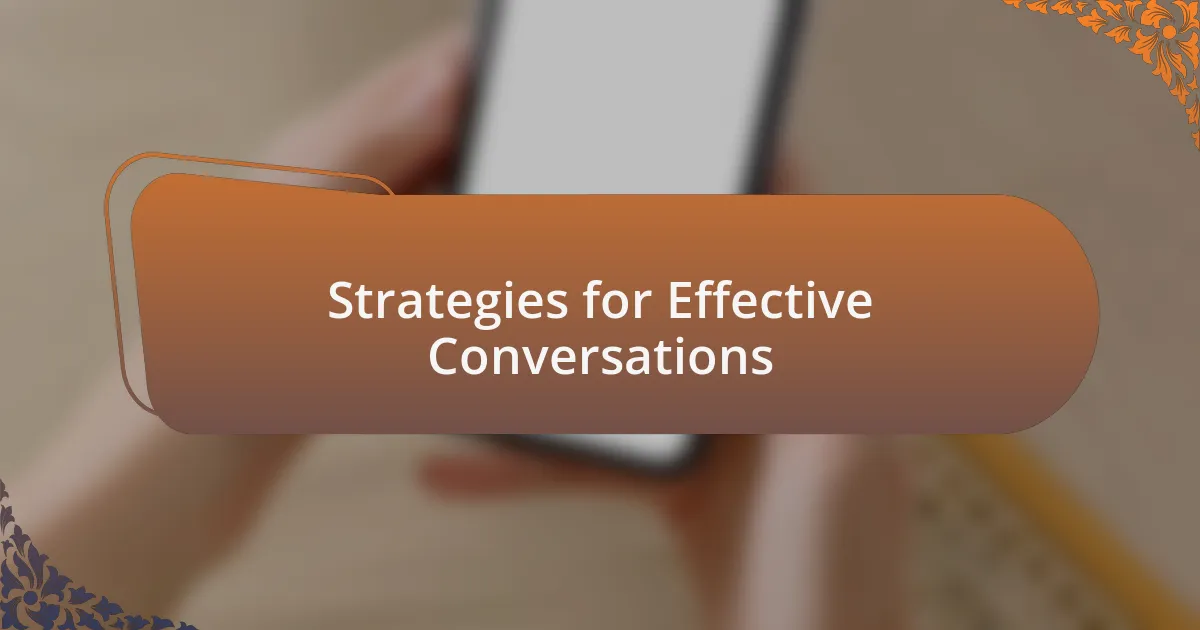
Strategies for Effective Conversations
One strategy I’ve found effective is to focus on active listening. I remember sitting at a table where a child was hesitant to engage. Instead of bombarding them with questions, I offered my full attention, maintaining eye contact and nodding slightly to show I was invested in their participation. This often encouraged them to share more, even if it was just a few words.
Another approach is to create a comfortable environment that fosters open dialogue. I once facilitated a small group session outdoors where the relaxed atmosphere seemed to ease the children’s anxiety. The laughter and natural setting led to spontaneous interactions that were previously absent in tense, closed spaces. Isn’t it fascinating how our surroundings can significantly influence the way we communicate?
Lastly, I’ve learned the power of patience. There was an occasion when a quieter child took several moments to muster the courage to speak. Instead of rushing them, I used the silence to my advantage, allowing them time to shape their thoughts. This not only validated their feelings but also demonstrated that their voice holds value. How often do we give others the space they need to express themselves?
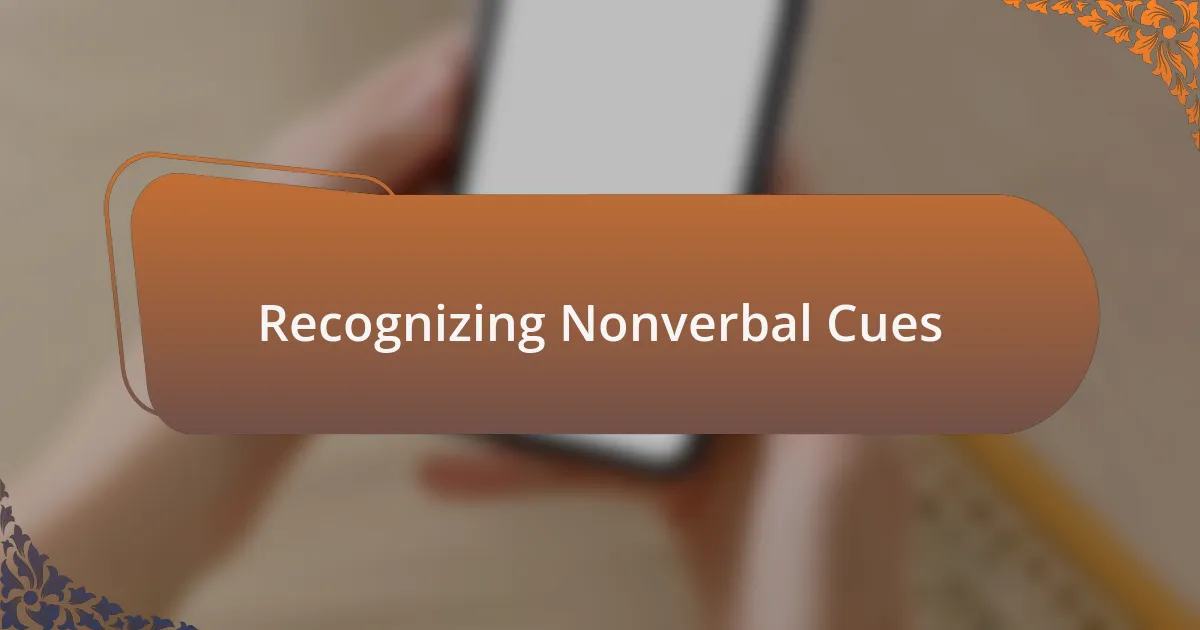
Recognizing Nonverbal Cues
Recognizing nonverbal cues is essential in any conversation, especially when engaging with individuals who may struggle to communicate verbally. I recall a moment when I was speaking with a child who seemed withdrawn. Their fidgeting hands and downcast eyes spoke volumes about their discomfort, prompting me to adjust my approach. By gently leaning in and softening my body language, I created a safer space that allowed them to express themselves more freely.
It’s intriguing how much information we derive from posture and facial expressions. Once, during a workshop, I noticed a participant crossing their arms tightly while listening. This nonverbal signal indicated defensiveness, perhaps stemming from past experiences. Rather than pressuring them to open up immediately, I acknowledged their presence with a warm smile and a welcoming tone, slowly inviting them into the conversation. Have you ever considered how your own body language might impact someone’s willingness to engage?
In my experience, situational awareness can enhance our understanding of nonverbal cues. On one occasion, I observed a child subtly shifting away from a group discussion. Recognizing this as a sign of anxiety, I gently approached them afterward. By using calm verbal reassurances and maintaining open body language, I was able to provide the comfort they needed to share their thoughts, however brief. It’s moments like these that reinforce the importance of tuning into not just what is said, but what remains unspoken.
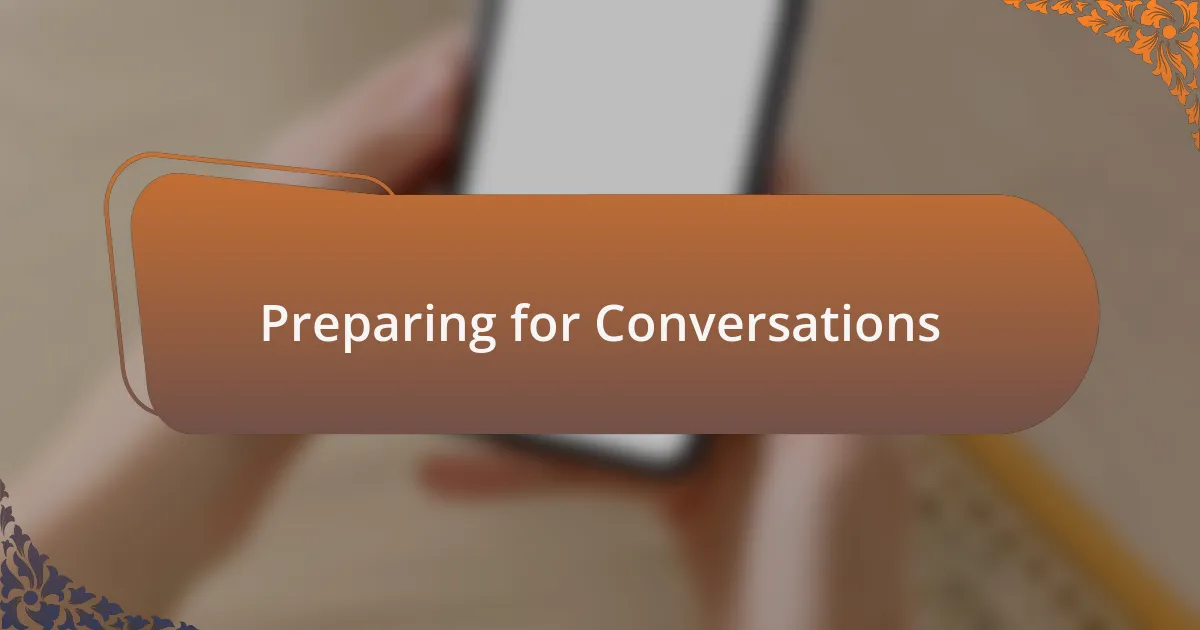
Preparing for Conversations
Preparing for conversations requires a thoughtful approach, especially when considering the needs of those who might find words difficult to articulate. I often take a moment to gather my thoughts before engaging in dialogue. For instance, during a recent discussion with a teenager I’ve been supporting, I noticed how my initial nervousness faded once I reminded myself to breathe and focus on the shared space rather than my anxiety. Have you experienced this shift in mindset before?
One of the strategies that I find effective is setting the scene physically and emotionally. Before having a conversation, I survey the surroundings and ensure they’re conducive for open dialogue—quiet, comfortable, and free of distractions. I remember setting up a cozy corner in my living room during a chat with a child who has selective mutism. By creating a familiar and inviting environment, I could sense their tension easing, making it easier for them to engage. What types of environments help you feel more at ease when communicating?
Additionally, I prepare by mentally outlining the key points I want to cover, anticipating potential responses, and allowing space for silence. I once helped a young girl by pausing and patiently giving her time to process her thoughts. Those extra moments of silence can be powerful and are often underestimated. Isn’t it fascinating how less really can be more in conversations?
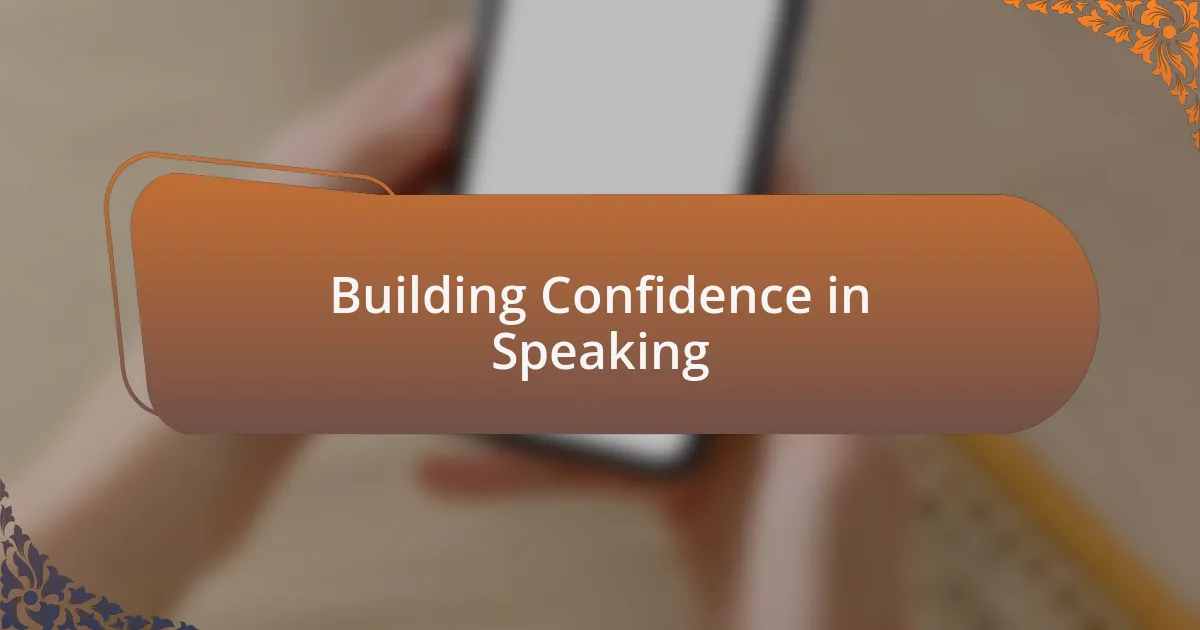
Building Confidence in Speaking
Building confidence in speaking often starts with small, meaningful interactions. I’ve noticed that one-on-one conversations can be less intimidating than larger group settings. For example, I once encouraged a young person to share their thoughts by starting with a simple question about their favorite hobby. That initial step allowed them to express themselves without the pressure of a larger audience. Have you ever felt more comfortable speaking about something you’re passionate about?
Practicing speaking in low-stakes situations is another approach I advocate. I remember role-playing with a child, where we pretended to order food at a restaurant. These playful scenarios not only made speaking feel less daunting but also helped build their confidence gradually. What if we treated each speaking opportunity—no matter how small—as a chance to grow?
Furthermore, positive reinforcement can make a significant difference. After a particularly challenging conversation, I always celebrate the effort, regardless of the outcome. It was heartwarming to see a shy teenager beam with pride after speaking up, even if it was just a few words. How often do we acknowledge the courage it takes to use our voices, even in the simplest of moments?
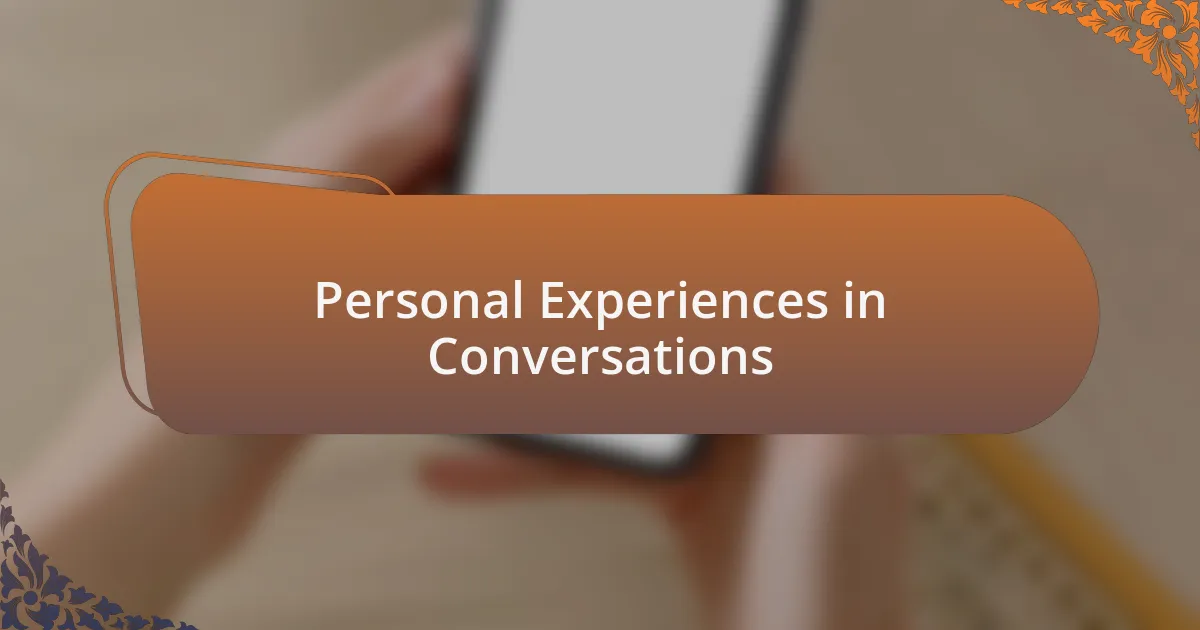
Personal Experiences in Conversations
When I think about my experiences in conversations, I often reflect on the power of active listening. There was a moment when I was talking with a young boy who struggled with speaking. I noticed that, as I focused on truly hearing him—nodding, maintaining eye contact—his anxiety lessened. Have you ever felt how just being present can create a safe space for someone to express themselves?
In another instance, I found myself in a conversation where silence felt heavy. Instead of rushing to fill the gaps, I allowed us both to sit in that stillness for a moment. It was a revelation to see how giving space can invite deeper thoughts. Isn’t it fascinating how sometimes the quiet can foster more meaningful dialogue than a flurry of words?
My own journey has highlighted the importance of self-awareness in conversations. I remember attending a group event where I observed myself withdrawing from the discussion. Understanding why I felt that way—fear of judgment—allowed me to push past it. How often do we stop to consider the motivations behind our own hesitance to speak?